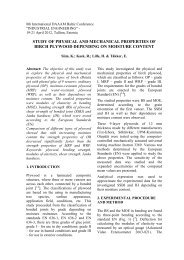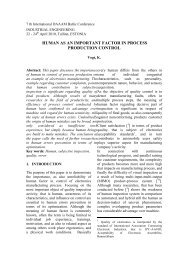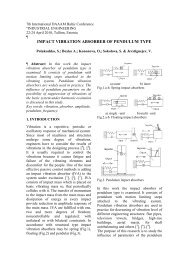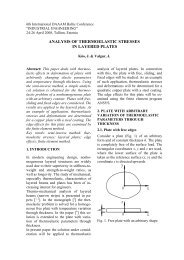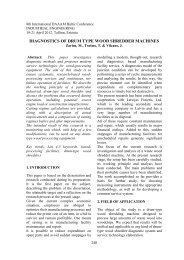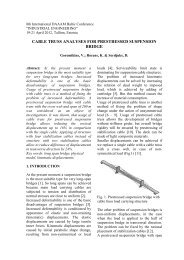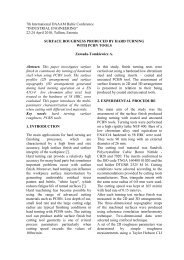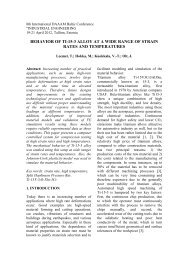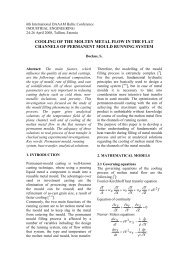Overview in PDF format - Tallinna Tehnikaülikool
Overview in PDF format - Tallinna Tehnikaülikool
Overview in PDF format - Tallinna Tehnikaülikool
Create successful ePaper yourself
Turn your PDF publications into a flip-book with our unique Google optimized e-Paper software.
is2.5. Dynamical model with two degrees of freedom2.5.1. Dynamical model with two degrees of freedom without damp<strong>in</strong>gThe differential equations of forced vibrations, caused by the cutt<strong>in</strong>g force F,accord<strong>in</strong>g to the theorem on k<strong>in</strong>etic moment, are presented <strong>in</strong> the follow<strong>in</strong>g form:2J0 & z&− Aω by&+ kzzl= Mzls<strong>in</strong>pt,2*J0& y+ Aω b z&+ k y yl = M ylcos pt + Frl1l+ Fal1lcosωt , (2.15)where ω * the angular velocity of blank rotation, 2M mp y l / 2ωy = b and2Mz= mp zbl/ 2 , y b and z b are the amplitudes of the foundation vibrations, k z andk y are spr<strong>in</strong>g constants, and A is the moment of <strong>in</strong>ertia of the blank <strong>in</strong> relation to theaxes of rotation.The general solution of Eqs (2.15) represents free vibrationsy1= a1s<strong>in</strong>( p1t+ α1)+ a2s<strong>in</strong>( p2t+ α2) ,(2.16)z1= µ1a1s<strong>in</strong>( p1t+ α1)+ µ2a2s<strong>in</strong>( p2t+ α2)where a 1 , a 2 , α 1 and α 2 are constants of <strong>in</strong>tegration to be determ<strong>in</strong>ed from the<strong>in</strong>itial conditions, µ 1 and µ 2 are ratios of the amplitudes of the two pr<strong>in</strong>cipalmodes of vibrations, p 1 and p 2 are the natural frequencies of vibrations withgyroscopic forces:22 2 22( J l ( k + k ) + A ) ± J l ( k + k )2 2 2 2 4 ⎞( 0 y z + A b ) − 4J0 l k y k z 0. J 0⎛p1,2= ⎜0 y z bω⎟ 5⎝⎠ω (2.17)Our analysis shows that with an <strong>in</strong>crease <strong>in</strong> the value of ω b the difference betweenthe higher and the lower frequencies, p 1 and p 2 , is <strong>in</strong>creased.It was found that for the first mode with the higher frequency p 1 , the ratio µ 1 waspositive, i.e. their vibrations y 1 and z 1 were <strong>in</strong> phase or <strong>in</strong> the so-called directprecession. For the lower frequency p 2 , their vibrations y 2 and z 2 were <strong>in</strong> theopposite phase or <strong>in</strong> the so-called reverse precession. In the first mode of vibration,a po<strong>in</strong>t of the blank axis moves along the circle <strong>in</strong> the direction of its own rotation,while <strong>in</strong> the second mode it moves <strong>in</strong> the direction opposite to rotation.A particular solution of Eqs (2.8), depend<strong>in</strong>g on the disturb<strong>in</strong>g force, representsthe forced vibrations of the system, which are represented as follows:whereB=*y2 = B cos pt + b cosω t + Fr l1/ k yl, (2.18)2 2M z l pA ω b − M y l ( k z l − J o p ),2 2 2 2 2 2 2p A ωb − ( k y l − J 0 p )( k z l − J 0 p )2 2M z l ( k y l − J o p ) − M y l p ω b2 2 2 2 2 2 2( k l − J p )( k l − J p ) − p A ωD = ,z 0 y 0b27



